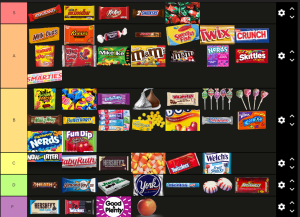Not so SWEETtart
Used with Permission by Wikimedia Commons/Harbin
This is the chemical structure of fentanyl. Rainbow fentanyl can vary in multiple shapes and colors to mimic a candy-like appearance.
November 3, 2022
Halloween is a substantial commercial holiday that brings in large profits for candy-based companies. Hundreds of thousands of homes provide trick-or-treater’s with a variety of candy, from small Tootsie Rolls to king sized Snickers. Although, in the past couple of years, parents have had to check candy collections for anything that could harm children. This year’s concern is that rainbow fentanyl will potentially be passed to unsuspecting trick-or-treaters.
According to the Drug Enforcement Administration (DEA), “Brightly-colored fentanyl is being seized in multiple forms, including pills, powder and blocks that resemble sidewalk chalk. Despite claims that certain colors may be more potent than others, there is no indication through DEA’s laboratory testing that this is the case. Every color, shape and size of fentanyl should be considered extremely dangerous.”
The DEA informs the public of the alarming emerging trend of colorful fentanyl available across the U.S. The pills are designed to look similar to SweetTarts or Skittles.
“[It] is a deliberate effort by drug traffickers to drive addiction amongst kids and young adults,” said DEA Administrator Anne Milgram.
Although the administration is bringing this precautionary alert to parents so that they check their children’s candy baskets/bags, Executive Director of the Louisiana Addiction Research Center, Dr. Nicholas Goeders claims that the pill is not mainly supposed to target children.
“This is an attempt to be able to smuggle more of the product across the border because if it looks like it’s something legitimate, then it might not be as likely to be seized,” said Goeders.
Even though rainbow fentanyl is not likely to wind up in the hands of young trick-or-treaters, Goeders urges parents and caregivers not to let their guards down. Advising parents to continue to check their child’s candy to ensure that their Halloween candy is in its original packaging and has not been opened.
The DEA claims that “Drug poisonings are the leading killer of Americans between the ages of 18 and 45… [and] Fentanyl remains the deadliest drug threat facing this country.” Despite Dr. Goeders’ claim that it is more of a smuggling situation than a threat towards young trick-or-treaters, we do not need to lower the age of deaths by drug poisoning.









